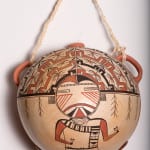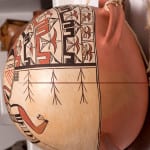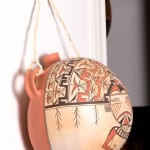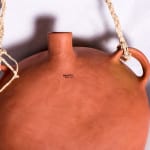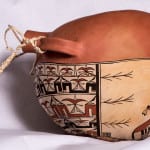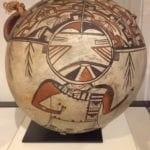10.0625” front to back (though the “flat” back is not actually flat, so this distance varies).
12.125” from spout to bottom, including the 1.5” spout.
11.3125” wide.
This is a huge canteen, only somewhat smaller than the large utility canteen that is also part of this collection (1998-01). Unlike the utility canteen, 2014-15 is quite light for its size, indicating that its walls are as thin as a much smaller pot. Large flat surfaces are prone to distort and crack when fired. The back of utility canteen 1998-01 cracked on firing and was native repaired. The back of this canteen was deformed by the heat of firing but did not crack. The handles of the canteen have medial grooves, as are characteristic of Nampeyo canteens; the spout on this modern canteen is built straight off the body. The front “belly” of the pot is particularly bulbous, as if the Polik’Mana was pregnant with life.
The Polik’Mana depicted here is variously called “ “Corn Grinding Maiden” or “Butterfly Maiden” although she is also a companion to the Poli Kachina of Third Mesa and (with slight modification) is the partner of the Salako Katchina (Wright, 1973:106). She also carries the name “Water Drinking (or Bearing) Girl and is not a katchina but rather a woman’s dance personage (Wright, 1977:54). The name seems to change with her function in a particular dance.
In any case she is one of the most beautify personages to appear at Hopi dances and is the frequent subject for Kachina carvers and for the last 150 years has often depicted on pottery, see 2005-07 and 2013-08 in this collection and Elmore (2015:138) for Polacca pots that are part of the Keam Collection at Harvard.
The most beautiful rendition of the Polik’Man is on a canteen made by Nampeyo, owned by Rosalind and Eugene Meieran, and included in the Heard Museum exhibit “Elegance From Earth.” 2012-2013. No pot uses its form to better project its design. Indeed, this may be the most beautiful pot Nampeyo ever made. (Arguable, but spend a while with the Meieran canteen.)
The Meierman canteen
Canteen 2014-15 is a reproduction of the Nampeyo original by great great granddaughter, Rachel Sahmie. Bill and I first saw the Nampeyo canteen at the Heard in March 2013; I returned with Mike McMullen 7 months later and, shooting through the glass case, took 9 photographs of the Meieran canteen from every side and angle. Working from these photographs, Rachel was able to reproduce the Nampeyo canteen both in form, size and design with almost perfect accuracy.
The spout of canteen 2014-15 does not tip forward, as on the Meieran canteen and the left hand of the Mana on Rachel’s canteen is held closer to her body than on the original. In addition, Nampeyo’s creation carries a beautiful patina. Nevertheless, though 125 years younger, canteen 2014-15 captures the stunning beauty of the original.
The design will be analized as if Nampeyo herself had painted the design, since (as Rachel would say) “Grandmother” guided her.
Five bands of design rise off the Polik’Mana’s face in the form of a huge tabula. These bands represent squash-blossom and stepped-cloud elements. For the first four bands, the squash flowers seem rooted in the linear cloud design, much as squash flourishes in moist soil. The top edge of the headdress is composed solely of squash blossoms.
As is typical of Nampeyo, color is used to integrate the massive headdress. The first row of stepped clouds above the forhead is painted red on the right and black on the left. This pattern reverses in the second row of clouds. The third band is based on all red cloud elements, the fourth row all black.
Such variation and order add both interest and harmony.
Similarly the number of squash blossims varies by row (2, 4, 4, 6, 12) working out from the head, with the middle row having larger renditions of this design that the other rows. These numbers are all even since it is much easier for an artist to divide space in half than thirds. The number of blossoms doubles from the first to the second row; the numbers of such elements in these first two rows sum to the number of squash blossoms in the fourth row. The number of blossoms in this fourth row doubles in the final row. Again, regularity of pattern is interrupted by difference as Nampeyo effortlessly intrigues the eye.
The face of the Polik’Mana is very similar to other Nampeyo renditions in this collection (bowl 2009-17, tile 2014-10 or tray 2017-04). This canteen lacks the pendant between the eyes of the other two ceramics. The canteen has a smooth arch over the segmented mouth like the bowl and in contrast to the tile, which has an inverted “V” shape,over the mouth. This element is red on both this canteen and the tile, but black on the bowl. The Polik’Mana on the bowl features branches hanging from the lower edge of the tabula; the tile displays turquiise earings and canteen 2014-15 has both. Although a Mana, the Polik can dance in its male or female form. Female gender is indicated by a red circle on the cheek (as on bowl 2009-17) or dances with lined triangles on the cheeks, representing its male persona (as on tile 2014-10 and the canteen discussed here).
The body of the Polik’Mana is fully represented on canteen 2014-15 and is painted with the same red/rust color as the pot’s bottom. She wears a multi-strand turquoise necklace, as is customary, and is draped in an embroidered shawl and kilt typical of katchina dancers, In her hands she holds prayer feathers. “Nampeyo favored diminutive bodies on her anthropomorths, typically with upturned arms with hands holding feathers, bows and arrows and rattles. In contrast to the body, the heads of human-like creatures were generally double or more in size with elaborate headdresses and face paint (Wade and Cooke, 2012:130).” On canteen 2014-15 the tabula and face fill about 58% on the vertical decorated space, with the body taking the remaining 42%. That’s not quite the “double” Wade mentions, but when seen from most angles, the tabula and then the face are most prominent, with the body hardly noticed.
In an article titled “A consumer’s Guide to Hopi Pottery,” Anne Hitchcock advises the buyer to consider the relationship between a pots shape and the layourt of the design (1977:26). This is good advice, and gets to the heart of why canteen 2014-15 is a great pot. More than any Hopi pot I have ever seen, Nampeyo (and great-great-grandaughter Rachael) take anvantage of the bulbous shape of this canteen. Polik’Man’s face thrusts forward toward the viewer, her elaborate tabula flowing behind. The result is spectacular and breathtaking — a wonder.


